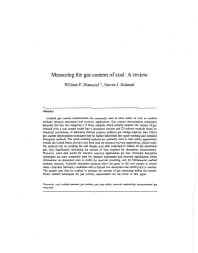Mining Publication: Measuring the Gas Content of Coal: A Review
Original creation date: February 1998
Authors: WP Diamond, SJ Schatzel
Int J Coal Geol 1998 Feb 35(1) :311-331
Coalbed gas content measurements are commonly used in mine safety as well as coalbed methane resource assessment and recovery applications. Gas content determination techniques generally fall into two categories: (1) direct methods which actually measure the volume of gas released from a coal sample sealed into a desorption canister and (2) indirect methods based on empirical correlations, or laboratory derived sorption isotherm gas storage capacity data. Direct gas content determination techniques may be further,subdivided into quick-crushing and extended desorption methods. The quick-crushing methods are primarily used in mine safety applications outside the United States, but have also been used for resource recovery applications. Quick-crushing methods rely on crushing the coal sample soon after collection to release all the desorbable gas, thus significantly shortening the amount of time required for desorption measurements. However, some data useful for resource recovery applications are lost. Extended desorption techniques are most commonly used for resource assessment and recovery applications where information on desorption rates is useful for reservoir modeling, and for fundamental coalbed methane research. Extended desorption methods allow the gases in the coal sample to desorb under controlled laboratory conditions until a defined low desorption rate cutoff point is reached. The sample may then be crushed to measure the amount of gas remaining within the sample. Direct method techniques for gas content measurement are the focus of this paper.

Int J Coal Geol 1998 Feb 35(1) :311-331
- Assessing the Methane Hazard of Gassy Coals in Storage Silos
- The Direct Method of Determining Methane Content of Coalbeds for Ventilation Design
- Methane Absorption in Oil Shale and Its Potential Mine Hazard
- Methane Diffusion Parameters for Sized Coal Particles: A Measuring Apparatus and Some Preliminary Results
- Methane Emission Rate Studies in a Northern West Virginia Mine
- Methane Emissions from Gassy Coals in Storage Silos
- Modeling and Prediction of Ventilation Methane Emissions of U.S. Longwall Mines Using Supervised Artificial Neural Networks
- Reservoir Engineering Considerations for Coal Seam Degasification and Methane Control in Underground Mines
- Reservoir Rock Properties of Coal Measure Strata of the Lower Monongahela Group, Greene County (Southwestern Pennsylvania), from Methane Control and Production Perspectives
- A Review of the Mechanisms of Gas Outbursts in Coal